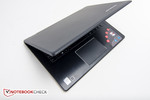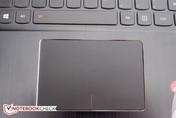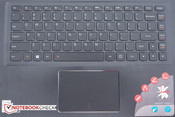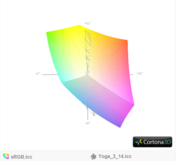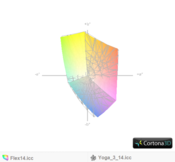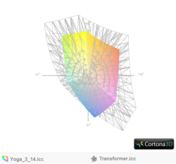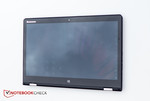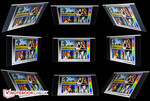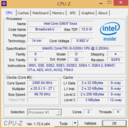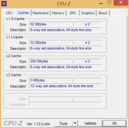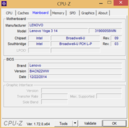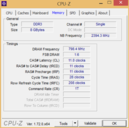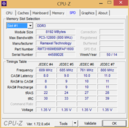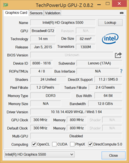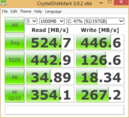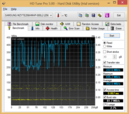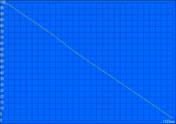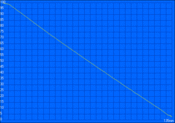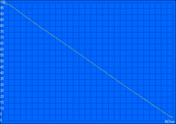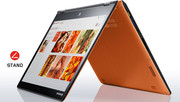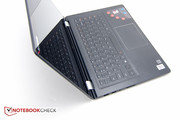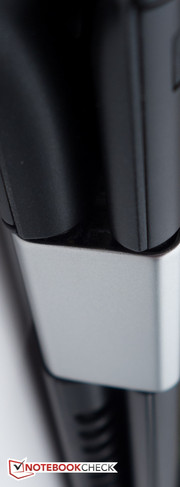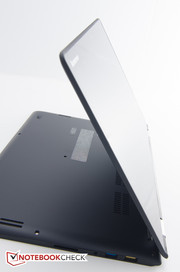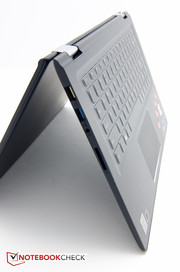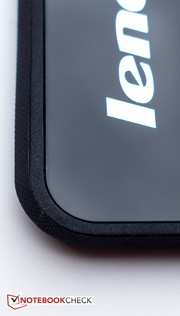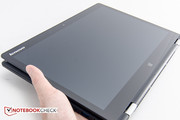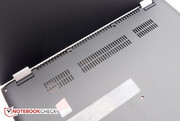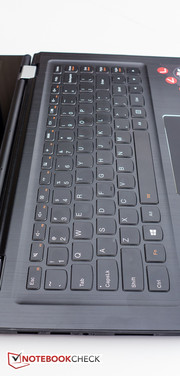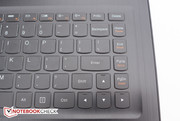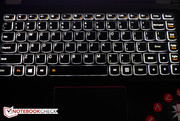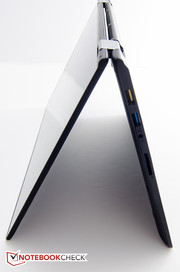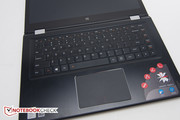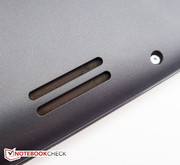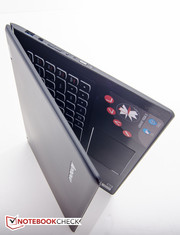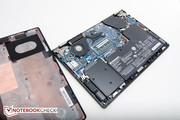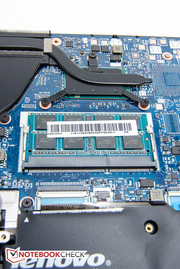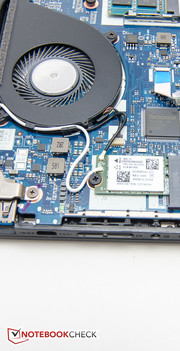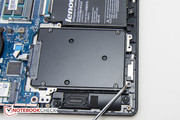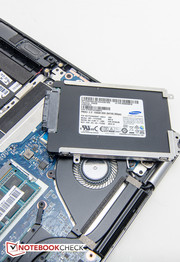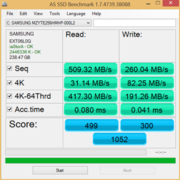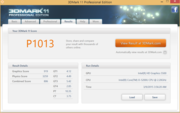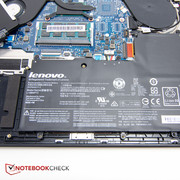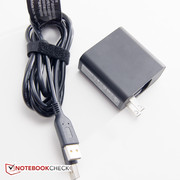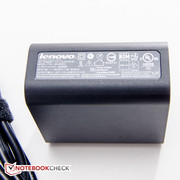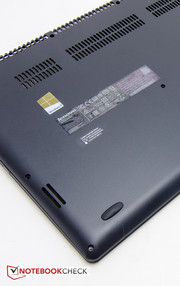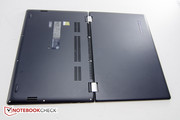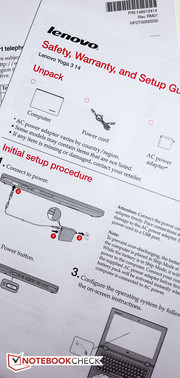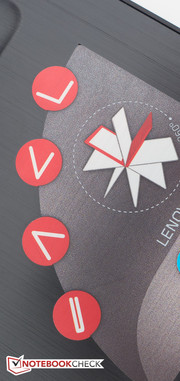Lenovo Yoga 3 14 Convertible Review
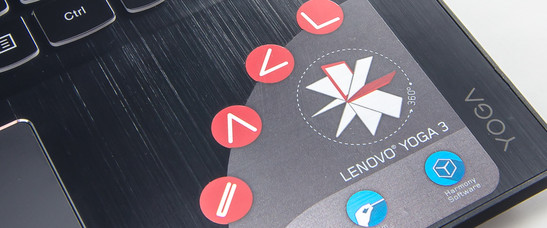
After the highly anticipated and ambitious Yoga 3 Pro convertible, Lenovo is at it again with the third iteration of its familiar 360-flip design for the more budget-conscious user, aptly named Yoga 3 14. As with all the models before, the flip-hinge allows the Yoga to convert from a standard-looking clamshell notebook to tablet, with two other modes in-between. While the Pro-version with its extremely lightweight design and impossibly thin chassis elicits "wows" from most who see it, it makes use of a slightly lower-performance fanless SoC design and comes with an ultra-high resolution QHD+ screen which can cause scaling issues and very tiny fonts. The price tag of $1200 might also bee too much for users with more modest budgets. Enter the Yoga 3 14, which, when quipped with a fifth-generation Broadwell i5-CPU, 4 GB of RAM and a 128 GB SSD, can be purchased for a more affordable $800.
At the time of writing, Lenovo offers six different models in the Yoga-series, ranging from the 11-inch Yoga 3 11 and the 12.5-inch ThinkPad Yoga up to the 14-inch review notebook, which - together with the ThinkPad Yoga 14 - has the largest screen size within the series. Even the previous-generation Yoga 2 Pro is still listed on the website at a steeply discounted price. In addition to the business-oriented ThinkPad Yogas and the Yoga 3 series, Lenovo also offers other convertibles like the ThinkPad Helix with detachable screen and the low-cost dual-mode Flex series consisting of 14-inch and 15-inch models. Of course, there are normally several different configurations to choose from within each model series.
In addition to the larger screen size, the Yoga 3 14 is now only offered with Solid State Drives, which should improve performance over the base-model predecessor Yoga 2 13 which had a conventional, platter-based hard drive with admittedly larger storage capacity. Our review notebook comes with an Intel i5-5200U processor, 8 GB of RAM, a 256 GB SSD and sells for $950. In what ways Lenovo was able to improve the new model and where the convertible still falls short is the subject of our review. During the course of our review and to get a better ideal about how the Yoga 3 14 stacks up, we'll not only compare the new entry to the predecessor Yoga 2 13, but also to the venerable Asus Transformer Book TF300LD with a discrete entry-level graphics card and Lenovo's own Idepad Flex 2 14.
Case
At first glance, the case design hasn't changed significantly compared to the predecessor Yoga 2 13, which isn't necessarily a bad thing. The new model has a marginally larger footprint at about 335 x 229 mm; the previous version measured 330 x 220 mm. Thickness has increased slightly from 15.5 to 18.3 mm, roughly as much as two dimes stacked on top of each other and the weight has increased from 1560 g to 1688 g, which is less than a 10 % increase and shouldn't be noticeable under normal circumstances as it still allows for easy commuting. The Idepad Flex 2 14 is not only larger, but also heavier at 2 kg and might not slip into a smaller bag quite as easily. The entire deck of the Yoga 3 14 is now made to look like brushed aluminum; the predecessor's deck was a smooth black color. In addition to the black review convertible, certain models are also offered in silver and white.
The top of the base unit does have some give, especially in the middle of the keyboard. Pressing on the lid causes ripples on the display and noticeable changes to the LED backlight. Neither the base unit nor the display are torsionally very rigid, although still within acceptable parameter. The outside of the convertible is soft-touch plastic, which isn't overly prone to fingerprints and feels quite nice in addition to adding slip resistance. The hinges appear unchanged and do a decent job holding the display securely in the various positions, although display bouncing is an issue when probing the touchscreen. A thin rubber bumper wraps around the base unit and the display as well and offers protection when the convertible is used in its various modes. Speaking of modes: just like the previous incarnations, the Yoga 3 14 still supports Laptop, Tent, Stand, and Tablet mode. We found ourselves mostly using the regular Laptop mode and the Tent mode for watching movies. Tablet mode certainly works as advertised, but carrying a tablet this large isn't for the faint of heart. When the screen is folded back, the keyboard and the touchpad deactivate to avoid accidental inputs. In stand mode, the keyboard faces the surface the surface the convertible is sitting on and while the keyboard is recessed enough to not protrude, care needs to be taken on surfaces that are not absolutely smooth to avoid damaging the keys.
It's important to note that since this is is a more affordable mainstream convertible, the overall build quality certainly doesn't offer much room for critique.
Connectivity
For a fairly slim convertible, the Lenovo Yoga 3 14 comes adequately equipped. The ports are located behind the mid-line, so connected peripherals don't really get in the way when using the convertible as a regular notebook with an external hard drive plugged in or when a monitor is connected. While the predecessor came with a single USB 2.0 and a single USB 3.0 port, the new model has two USB 3.0 ports. The USB 2.0 port is actually not available when the Yoga is plugged in, as Lenovo uses a charge / USB 2.0 port combo-design.
While the Flex 14 and the Asus Transformer Book TF300LD both feature a full-sized HDMI port, the Lenovo Yoga 3 14 only comes with a micro-HDMI port, which requires the user to purchase a suitable adapter. The position of the power button on the right hand side is a matter of taste, but we inadvertently triggered it a few times when picking the convertible up from the desk. The screen lock button is very small, although easy to find when probing the edge. When rotating, the display does take a couple of seconds before switching orientation.
Communication
A WLAN adapter from Qualcomm - an Atheros QCA61x4 - supports 802.11 standards a, g, n, ac and has Bluetooth 4.0 on board as well. During our time with the notebook we never experienced any degradation in signal quality or unexpected dropouts. The wireless reception strength is very good as well and the Windows indicator still showed five full bars when connected to the 5 GHz band and roughly 15 meters away from our Netgear R7000 Nighthawk router. While this is of course not a scientific test, it can be expected that the Yoga 3 14 will handle wireless connections even in larger homes with ease.
Accessories
Aside from the modular power adapter and a USB charging cable, the box the Yoga ships in is empty. While the power adapter is very light at under 200 g, the 6-foot cable might be too short for some usage case scenarios. On their website, Lenovo offers a 40 W slimline travel adapter and a protective sleeve for $50 each. A ThinkPad Basic USB 3.0 Dock costs $102; a micro-HDMI to HDMI adapter sells for $16.
Maintenance
A total of 11 Torx screws need to be removed before the entire bottom panel can be taken off. The single RAM module is not soldered onto the motherboard, so replacing or upgrading in the future shouldn't be much of a problem. The hard drive is a regular 2.5-inch model which can be removed after loosening four screws, although it's important to note that this is an ultra-slim drive which is only 5 mm thick.
Warranty
Lenovo covers the Yoga 3 14 for 12 months against manufacturer's defects. An upgrade from the standard depot warranty to 12 months in-home service costs $19; a 2-year in-home and accidental damage protection is available for a reasonable $79. 2-year and 3-year depot warranties sell for $49 and $99, respectively. Lenovo also sells a "Secure, Connect and Configure Setup Service" for less experienced users for $59. This service covers the connection of the convertible to a home network and the setup of a printer and an email account, among other things.
Input Devices
Keyboard
The keyboard is the typical chiclet design (called AccuType) Lenovo uses for consumer-grade notebooks and appears to be a direct carry-over from the Yoga 2 13. As such, key travel is on the shallow side and the feedback is borderline spongy, which is negatively amplified by the high degree of flex especially in the middle of the deck. The layout also might take some getting used to with its inverted function-row design and the various keys which are not full size (Tab key on the left; Backspace and Enter on the right side, for example). Despite the fact though that the keyboard doesn't compare to what is offered on ThinkPad models, we still founded it easy to type at a very good clip with a low error rate. We appreciate that Lenovo included a backlight, as this is not always a given in this price range: the base version of the Asus Transformer Book Flip, for example, lacks one. Although only simple on/off functionality is provided, we found the brightness to be just right. An auto-turnoff feature is not implemented, so the backlight stays on even when the display is turned off.
Touchpad
The Elan Smart-Pad measures 105 mm across and works very well. We found the size to be sufficient for the given screen real estate. Fingers glide easily across the slightly rough surface and we had no issues with multitouch gestures; Windows 8 gestures also worked without a hitch. As a clickpad, the entire surface of the pad is clickable, but we found it much easier to only use the lower half of the pad as the response is much better. The feedback of the clicks is quite good and audible as well without being overly loud.
Touchscreen
The 10-finger touchscreen is responsive as well and we neither had any issues with input accuracy, nor did we ever notice any appreciable lag during operation. Using the touchscreen is particularly intuitive and easy in Tent mode, as the display edge rests on the desk surface and there is no display bounce whatsoever.
Display
The Yoga 3 14 comes with a 14-inch IPS FHD LED display and a resolution of 1920 x 1080 pixels. Other display panel types ore different resolutions are not offered. The resolution is is identical to the one of the predecessor and although the pixel density is now slightly lower (156 vs. 166 PPI), we still think that this particular resolution works rather well and hits the sweet spot for displays in the 13 to 14-inch range. With an average of 225 nits, the screen unfortunately isn't very bright and in fact just marginally brighter than the budget-oriented Flex 2 14 (215 nits). At least the brightness doesn't drop further when the convertible is running on battery power. The Asus Transformer Book Flip clearly outperforms our review convertible with 331 nits and even the older Yoga 2 13 gets brighter at just under 250 nits. The black value of 0.394 cd/m² results in a slightly dissatisfying contrast ratio of 595:1 - especially disappointing when one considers the cheaper Flex 2 14, which has a contrast ratio north of 1000:1. Still, neither the Transformer Book Flip nor the previous-generation Yoga 2 13 do much better than the review convertible. Blacks are still reasonably dark and typical uses like watching movies aren't impacted at all. We did find the noticeable display bleed around the edges a bit distracting when watching wide-screen movies with the black bars on the top and the bottom.
| |||||||||||||||||||||||||
Brightness Distribution: 82 %
Center on Battery: 234.6 cd/m²
Contrast: 595:1 (Black: 0.394 cd/m²)
ΔE ColorChecker Calman: 5.22 | ∀{0.5-29.43 Ø4.78}
ΔE Greyscale Calman: 3.35 | ∀{0.09-98 Ø5}
36.92% AdobeRGB 1998 (Argyll 1.6.3 3D)
Gamma: 2.27
CCT: 6184 K
| Lenovo Yoga 3 14 HD Graphics 5500, 5200U, Samsung SSD PM851 256 GB MZYTE256HMHP | Lenovo Flex 2 14 GeForce 840M, 4010U, Samsung SSD PM851 128 GB MZ7TE128HMGR | Asus Transformer Book Flip TP300LD-C4031H GeForce 820M, 4510U, SanDisk SD6SB1M128G1002 | Lenovo Yoga 2 13 HD Graphics 4400, 4010U, WD Blue UltraSlim WD5000MPCK-22AWHT0 | Lenovo Yoga 2 Pro HD Graphics 4400, 4200U, Samsung SSD PM841 MZMTD128HAFV mSATA | |
|---|---|---|---|---|---|
| Display | |||||
| Display P3 Coverage (%) | 38.81 | 74.4 | 65.5 | 42.03 | |
| sRGB Coverage (%) | 58.2 | 98.9 | 96.2 | 63.3 | |
| AdobeRGB 1998 Coverage (%) | 40.12 | 72.6 | 67.7 | 43.42 | |
| Screen | 15% | 18% | 16% | 15% | |
| Brightness middle (cd/m²) | 234.6 | 216 -8% | 345 47% | 269 15% | 371.5 58% |
| Brightness (cd/m²) | 225 | 215 -4% | 331 47% | 249 11% | 340 51% |
| Brightness Distribution (%) | 82 | 88 7% | 93 13% | 86 5% | 87 6% |
| Black Level * (cd/m²) | 0.394 | 0.21 47% | 0.47 -19% | 0.4 -2% | 0.749 -90% |
| Contrast (:1) | 595 | 1029 73% | 734 23% | 673 13% | 496 -17% |
| Colorchecker dE 2000 * | 5.22 | 4.56 13% | 4.82 8% | 2.95 43% | 3.14 40% |
| Greyscale dE 2000 * | 3.35 | 3.51 -5% | 4.97 -48% | 4.19 -25% | 1.24 63% |
| Gamma | 2.27 97% | 2.53 87% | 2.35 94% | 2.5 88% | 2.44 90% |
| CCT | 6184 105% | 6401 102% | 6435 101% | 6771 96% | 6461 101% |
| Color Space (Percent of AdobeRGB 1998) (%) | 36.92 | 37 0% | 64 73% | 62.1 68% | 40.49 10% |
| Total Average (Program / Settings) | 15% /
15% | 18% /
18% | 16% /
16% | 15% /
15% |
* ... smaller is better
To get an idea of the color accuracy of the panel we use the CalMAN 5 software and a colorimeter. While the grayscale DeltaE average of 3.35 is very good indeed, the ColorChecker DeltaE average of 5.22 is a little less impressive, especially since a closer look reveals that blue is an outlier with a max DeltaE of over 11. Still, the color accuracy is certainly adequate for every day use and most users will be happy with vivid colors the panel produces.
As always, we also take a look at the coverage of the professional color spaces. Even compared to sRGB, the panel fails to impress with only 53 % coverage. The older Yoga 2 13 was able to reproduce 84 % - a much better result. The larger AdobeRGB color space is covered to only 37 %; the Asus Transformer Flip is significantly better at 64 %. Overall, the display appears to be a step backwards when compared to the predecessor Yoga 2 13 and its performance is now closer to the inexpensive Flex 2 14. Of course most users won't notice the lack of color space coverage, but semi-professional photographers clearly need to look elsewhere.
Outdoor usability is very restricted since the display doesn't get nearly bright enough to overcome the reflections produced by the glare-type panel. Direct sunlight has to be avoided at all costs and even overcast skies drown out the picture more or less completely. Only in the shade and with the display angled in a way to minimize reflections is it possible to identify the screen content. Using the Yoga 3 14 as a tablet to read a book is thus only really only possible indoors and with no strong light sources present.
As it is typical for IPS display, the viewing angle stability is outstanding and even very shallow angles are possible, although the brightness does decrease a bit. The protective glass on top of the screen seems to be close enough to the panel to not cause any issues with internal reflections, so text remains readable at all times. Budget convertibles like the HP Pavilion 13-a000ng x360 with TN panel are clearly inferior here.
Performance
At the time of writing, Lenovo offers two processor choices courtesy of Intel's 5th-generation lineup. Our review convertible is equipped with an Intel Core i5-5200U processor running at a nominal clock speed of 2.20 GHz; the top-of-the-line model comes equipped with an Core i7-5500U Processor running at a 2.4 GHz. The RAM varies as well with the entry-level system having to make do with 4 GB; the other versions are equipped with 8 GB of single-channel LPDDR3 1600 MHz RAM. Hard drive choices are either a 128 GB (base model) or 256 GB SSD from Samsung.
Processor
The Intel Core i5-5200U is a 14 nm ULV (ultra low voltage) dual-core Broadwell-generation CPU with a nominal frequency of 2.2 GHz. Hyper-Threading is of course enabled and the Turbo can overclock a single core to 2.7 GHz and both cores to 2.5 GHz. With Cinebench R11.5 scores of 1.25 (single) and 2.83 (multi), Lenovo's implementation scores towards the top range of the notebooks we've tested so far. Performance-wise, the new CPU lags only about 7 - 8 % behind the previous-generation Intel Core i7-4510U installed in the Asus Transformer Flip, which reaches up to 2.8 GHz for both cores. According to the benchmark wPrime, the i5-5200U is about 14 % faster than the previous-generation Haswell Core i5-4200U, which was a very popular choice for mid-range Ultrabooks and thin-and-lights. With a TPU of 15 watts, the new CPU does consume quite a bit more power (10.5 watts, to be exact) than the particularly frugal Intel Core M-5Y70 SoC in Lenovo's high-end Yoga 3 Pro convertible, but unlike that particular SoC, it shouldn't be affected by throttling due to TPU constraints nearly as much.
System Performance
To get an idea of the system performance, we use the synthetic PCMark benchmark tests. With a score of 4659 for PCMark 7, the Yoga 3 14 performs about 22 % better than the less expensive Flex 2 14, but falls short of the Asus Transformer Flip, which has a weaker Core i3 processor but - thanks to a dedicated NVIDIA GeForce 820M graphics card - was able to score 4976 points (+ 7 %). Perceived performance is simply outstanding: shutdowns and boots are exceedingly quick at 2 seconds and 6-7 seconds, respectively and programs launch without any delay. Even during heavy multi-tasking sessions, we didn't experience any significant slowdowns. A check with various benchmarks showed that the performance does not change no matter if the convertible is running on battery or plugged in, so full power is available at all times.
| PCMark 7 Score | 4659 points | |
| PCMark 8 Home Score Accelerated v2 | 2795 points | |
| PCMark 8 Creative Score Accelerated v2 | 3756 points | |
| PCMark 8 Work Score Accelerated v2 | 3315 points | |
Help | ||
Storage Devices
As we mentioned earlier, the SSD is a 2.5-inch 5 mm model ourtesy of Samsung. The PM851 is capable of very good performance with reported sequential read / write speeds of around 510 MB/s and 260 MB/s according to AS SSD. The 4K read and write speeds are also top notch. The 128 GB SanDisk drive in the Transformer Book Flip was slightly slower at 470 MB/s and 245 MB/s, respectively. Compared to the Lenovo Yoga 2 13 with its conventional platter based drive, the SSD in the Yoga 3 14 offers roughly 5x faster read and 2.7x faster write speeds.
* ... smaller is better
Gaming Performance
The Intel Core i5-5200U features an integrated HD Graphics 5500 GPU with 24 Execution Units (EUs) clocked and is clocked at 300 - 900 MHz. Although the new graphics card is able to outperform the previous-generation Haswell GPUs HD Graphics 4400 and HD Graphics 5000, the gaming performance is nothing to get overly excited about. A check with a synthetic benchmark test confirms that the HD 5500 is capable of better performance than the previous generation of integrated GPUs: with 1013 points, the HD 5500 handles the 3DMark11 test approximately 11 % faster than the HD 4400 in the Yoga 2 13. This still doesn't mean that the Yoga 3 14 is a gaming machine - far from it: only older and less demanding games are playable without stutters and slowdowns. Newer and resource-intensive games require the lowest resolution and the lowest settings to be playable at all. Of course, the performance of the GPU should theoretically be higher with dual-channel memory, but a quick comparison to the Aspire R13 R7, which is equipped with the same CPU and GPU, but 8 GB of dual-channel memory, only shows a marginal performance improvement.
The Asus Transformer Book Flip is better equipped to handle games, as it comes with a dedicated Nvidia Geforce 820M graphics card. Synthetic benchmark tests show that the lead is not always a commanding one with differences of between 5 and 30 %. Still, even a few fps more can make all the difference, so the Transformer Flip clearly has the edge.
| low | med. | high | ultra | |
|---|---|---|---|---|
| Anno 2070 (2011) | 53.2 | 26.6 | 15.9 | 7.9 |
| Company of Heroes 2 (2013) | 16.5 | 12.8 | 7.8 | 2.8 |
| Fifa 14 (2013) | 97.5 | 67 | 48.3 | 40.3 |
| Thief (2014) | 13 | 9 | 7 | 3.2 |
| GRID: Autosport (2014) | 29.2 | 22.5 | 13.6 | 12.5 |
| 3DMark 06 Standard Score | 6041 points | |
| 3DMark Vantage P Result | 4030 points | |
| 3DMark 11 Performance | 1013 points | |
| 3DMark Ice Storm Standard Score | 42707 points | |
| 3DMark Cloud Gate Standard Score | 4537 points | |
| 3DMark Fire Strike Score | 610 points | |
Help | ||
Emissions
System Noise
During idle, the fan of the Yoga 3 14 seems to be running most of the time, although at around 32 dB it is not loud enough at to be audible above the noise floor of an average room. During the stress test, the noise level climbed to just above 37 dB, which is not quite as loud as the predecessor at almost 40 dB or the Transformer Flip at about 43 dB. Unfortunately, the sound emitted has a fairly high frequency, so the noise during the stress test got a little annoying after a while. Of course, this is only an issue during loads that approach 100 % CPU and GPU utilization.
Noise level
| Idle |
| 32.2 / 32.5 / 32.6 dB(A) |
| Load |
| 33.6 / 37.2 dB(A) |
 | ||
30 dB silent 40 dB(A) audible 50 dB(A) loud |
||
min: | ||
Temperature
Since Lenovo employs fairly aggressive temperature management (see the section on the stress test below), the temperatures are well controlled. During idle the temperature just reaches about 26 degrees C, which is just 7 degrees C above ambient. During load, the convertible reaches 44 degrees C in the middle on the bottom. Since the temperature on the left and right edges reaches only about 27 degrees C, placing the convertible on the lap in notebook mode is possible without any issues. The predecessor reached 48 degrees on the left bottom edge, which makes lap use highly uncomfortable. The Asus Transformer Flip topped out at 46 degrees C, so it got slightly warmer than the Yoga 3 14.
(+) The maximum temperature on the upper side is 34.6 °C / 94 F, compared to the average of 35.4 °C / 96 F, ranging from 19.6 to 60 °C for the class Convertible.
(±) The bottom heats up to a maximum of 44.4 °C / 112 F, compared to the average of 36.8 °C / 98 F
(+) In idle usage, the average temperature for the upper side is 22.7 °C / 73 F, compared to the device average of 30.3 °C / 87 F.
(+) The palmrests and touchpad are cooler than skin temperature with a maximum of 23.8 °C / 74.8 F and are therefore cool to the touch.
(+) The average temperature of the palmrest area of similar devices was 27.9 °C / 82.2 F (+4.1 °C / 7.4 F).
Stress Test
To identify potential throttling issues and to check if a review notebook exhibits any unusual behavior during high load levels, we subjected the Lenovo Yoga 3 14 to our stress test. At first, we start Prime95 on its own to stress the CPU. At the beginning, both cores ran at a speed of 2.5 GHz with one or the other core accelerating to 2.7 GHz. Within ten seconds, the temperature had jumped from 32 degrees C to 60 degrees C with both cores remaining a stable 2.5 GHz. About 8 minutes into the test, the temperature had increased to 63 - 64 degrees C, which brought an increase in fan speed with it. The cores still remained at 2.5 GHz, however. After a total of 15 minutes, the CPU reached 67 degrees C, which resulted a further increase in fan speed, an extremely short dip of the cores down to 800 MHz, a drop in temperature to about 52 degrees C and subsequently an almost instantaneous recovery of the CPU core speed back up to 2.5 GHz. This cycle repeated every 30 seconds or so. Although technically throttling, the decreases to 800 MHz only took split seconds, so it is very doubtful that the performance would've taken a measurable hit.
With the GPU stress component Furmark running, we observed initial GPU core and memory speeds of 900 and 800 Mhz, respectively. Within a few minutes, the GPU clock started dropping to 750 MHz occasionally at a temperature of about 65 degrees. After 15 minutes, the GPU clock stabilized at 750 MHz for the core and 800 MHz for the memory at a temperature of 66 - 67 degrees C.
With Prime95 and Furmark running in parallel, the CPU cores dropped to around 1.4 - 1.5 GHz. The GPU maintained 750 MHz at a temperature of 65 degrees. Even after several hours, this values hadn't changed at all. In summary, it appears that Lenovo has taken a rather conservative approach as far as making sure that overheating is not an issue. At no point of our various tests did we see an increase of the temperatures to above 71 degrees C. Although the CPU is indeed subjected to throttling, we need to note that a prolonged load scenario like the one we've simulated is rather unlikely to occur during normal use.
Speakers
The stereo speakers are located on the bottom on the left and right edge in the front half with the convertible is in Laptop mode. While the sound is clear and the maximum volume quite loud without any distortion, mids and of course bass are lacking a bit. Because the speakers fire downwards, placing the convertible on a hard surface does improve the sound quality. Still, the quality of the speakers is in line with our expectations: for watching movies, the sound quality is sufficient, but for listening to music, we recommend plugging in external speakers or headphones.
Battery Life
The Lenovo Yoga 3 14 is equipped with a 45 Wh battery - down from the predecessor's, which shipped with a 54 Wh battery. Despite the downsizing, the battery life has improved significantly: during our practically very relevant WLAN test, the review convertible managed to run for 7 hours and 50 minutes, which is a huge increase over the Yoga 2 13 at just around 5 hours. The Asus Transformer Book Flip TP300LD-C4031H shut down about an hour sooner than the review notebook. For the WLAN test, we activate the balanced profile, reduce the screen brightness to about 150 nits and simulate browsing conditions with an automated script. Idle runtime, which we establish with the BatteryEater Reader's Test (minimum screen brightness, power-saver profile) is up as well at nearly 20 hours. Even the full-load scenario with the Classic Test shows very good performance as well at 2 hours and 15 minutes. The Lenovo 2 13 needed to be plugged in again after about 1 hour and 40 minutes. The Flex 2 14, which has a smaller 32.5 Wh battery, only lasted an hour.
Verdict
Updated hardware, larger screen, better battery life - what's not to like? The Yoga 3 14 improves upon the predecessor Yoga 2 13 in quite a few areas. Despite the larger 14-inch screen and the smaller battery, the new model is capable of better performance and significantly longer battery life. The 256 GB Samsung SSD is blazingly fast and the boot, shut down, and application launch times are truly impressive. The convertible remains reasonably quiet under normal circumstances and handles high-load scenarios without ever breaking a sweat. The input devices work quite well for a consumer device and the keyboard features a backlight as well, which is a very nice-to-have feature. The various modes work well, although we'd recommend avoiding the Stand mode, since the keyboard is unprotected and touches the surface it is sitting on.
Unfortunately, the new screen is not as bright as the predecessors, which wasn't really that bright to begin with, and only covers about half of the sRGB color space. Outdoor use in bright conditions is severely limited, so users who need to venture outside a lot need to look elsewhere. One options is Lenovo's own older Yoga 2 Pro, which offers a significantly brighter QHD+ display (340 nits, 3200 x 1800 pixels). At the time of writing, Lenovo is selling the version with Core i5-4210U, 8 GB of RAM, and 256 GB SSD for about $850. The Asus Transformer Book Flip also has a brighter screen and offers a dedicated entry-level graphics card, so its gaming performance is a bit better. Acer's Aspire R13 R7 is also a decent, albeit very unconventional choice, although the manufacturer's US website only offers the previous-generation Haswell-equipped models at this time with a starting price of $900. Value-conscious buyers might also want to take a look at the the Lenovo Flex 2 14, which only supports two modes, but still comes with an IPS display despite the fairly low starting price of only $530.




